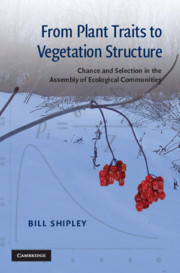 From Plant Traits to Vegetation Structure
From Plant Traits to Vegetation Structure Book contents
- Frontmatter
- Contents
- Preface
- 1 Playing with loaded dice
- 2 Population-based models of community assembly
- 3 Trait-based community ecology
- 4 Modeling trait-based environmental filters: Bayesian statistics, information theory and the Maximum Entropy Formalism
- 5 Community dynamics, natural selection and the origin of community-aggregated traits
- 6 Community assembly during a Mediterranean succession
- 7 The statistical mechanics of species abundance distributions
- 8 Epilogue: traits are not enough
- References
- Index
6 - Community assembly during a Mediterranean succession
Published online by Cambridge University Press: 05 June 2012
- Frontmatter
- Contents
- Preface
- 1 Playing with loaded dice
- 2 Population-based models of community assembly
- 3 Trait-based community ecology
- 4 Modeling trait-based environmental filters: Bayesian statistics, information theory and the Maximum Entropy Formalism
- 5 Community dynamics, natural selection and the origin of community-aggregated traits
- 6 Community assembly during a Mediterranean succession
- 7 The statistical mechanics of species abundance distributions
- 8 Epilogue: traits are not enough
- References
- Index
Summary
Theory can be dangerously seductive. Once one has built up an argument that is internally consistent, and once conclusions appear to follow inexorably from premises through clean lines of logic, it is sometimes enticing to conflate logical argument with reality. A good defense against such logical seduction is to let Nature into the conversation. A proper empirical evaluation of the method presented in Chapter 4 would involve an accurately measured environmental gradient involving all of the relevant environmental variables driving natural selection plus measured values of the key functional traits that respond to this selection of all species in the regional pool. This would be replicated in different localities along with evidence of quantitative generality of the community-aggregated traits. Hopefully, this book will have sufficiently convinced you of the potential of the approach that you will contribute to the hard work of assembling such empirical information. When this is done then we will know if the model actually works.
I'm easy to seduce. I think that it will work. However, I'm old enough to know the difference between seduction and commitment and I have had enough experience with field ecology to know that it might not work after all. I certainly won't hang myself in the barn if the model fails. As Thomas Henry Huxley famously pointed out, many beautiful theories have been killed by ugly facts.
- Type
- Chapter
- Information
- From Plant Traits to Vegetation StructureChance and Selection in the Assembly of Ecological Communities, pp. 199 - 212Publisher: Cambridge University PressPrint publication year: 2009


